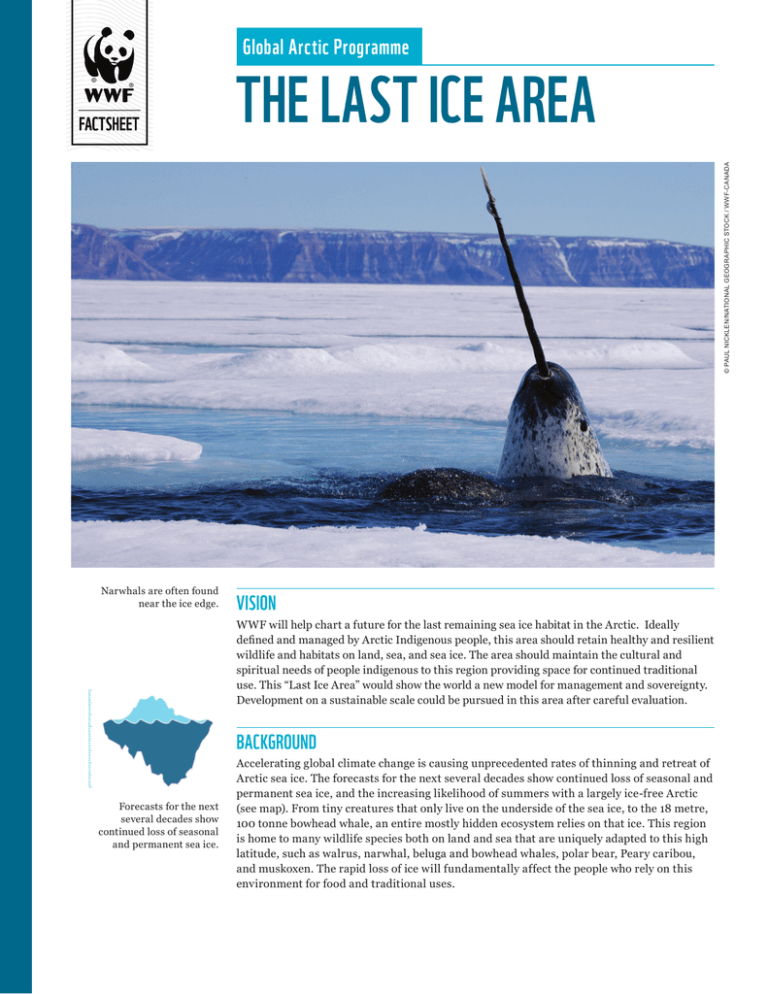tHE LaSt icE arEa global arctic programme ViSion
advertisement

global arctic programme © Paul NicKleN/NaTioNal geogRaPhic sTocK / WWF-caNada tHE LaSt icE arEa Narwhals are often found near the ice edge. ViSion WWF will help chart a future for the last remaining sea ice habitat in the Arctic. Ideally defined and managed by Arctic Indigenous people, this area should retain healthy and resilient wildlife and habitats on land, sea, and sea ice. The area should maintain the cultural and spiritual needs of people indigenous to this region providing space for continued traditional use. This “Last Ice Area” would show the world a new model for management and sovereignty. Development on a sustainable scale could be pursued in this area after careful evaluation. BacKgroUnd Forecasts for the next several decades show continued loss of seasonal and permanent sea ice. Accelerating global climate change is causing unprecedented rates of thinning and retreat of Arctic sea ice. The forecasts for the next several decades show continued loss of seasonal and permanent sea ice, and the increasing likelihood of summers with a largely ice-free Arctic (see map). From tiny creatures that only live on the underside of the sea ice, to the 18 metre, 100 tonne bowhead whale, an entire mostly hidden ecosystem relies on that ice. This region is home to many wildlife species both on land and sea that are uniquely adapted to this high latitude, such as walrus, narwhal, beluga and bowhead whales, polar bear, Peary caribou, and muskoxen. The rapid loss of ice will fundamentally affect the people who rely on this environment for food and traditional uses. International discussions regarding the future of the area where the sea ice will persist the longest have already begun. One idea that has captured significant interest is that of an “Ice Refuge”, envisioned as a large special management area where priority is given to conserving habitat for ice dependent species. These discussions are currently taking place in academic circles. WWF believes local people have the authority and should take the lead in deciding the future of this important area. last ice area • january 2012 Planning for management of the Last Ice Area is not the ultimate solution for securing a future for the sea ice ecosystem. Only action on reducing climate change can do that, but we believe planning for the future of the ice that will remain longest will give the ecosystem the best chance to recover from the effects of climate change. WWF believes local people have the authority and should take the lead in deciding the future of this important area, and we have been working to ensure Inuit organizations are informed and involved. Our role is to facilitate discussion around the future management of this Last Ice Area, add capacity (financial and technical), and coordinate international interest. We are reviewing potential domestic and international frameworks for future management of this area. Legal designations and management policies could vary, including protected areas such as the existing national parks, as well as areas with commercial and industrial uses. The “Last Ice Area” could be a multi-zoned complex of designated areas that are unified by the commitment to habitat conservation for ice dependent species while protecting the cultural heritage and economic needs of local people. Projected Sea Ice Extent, September 2040 This map shows the lowest extent of sea ice for 2040. Produced by WWF-Canada, march 29 2010 data sources: predicted september 2040 sea ice extent, > 15% conc., ucar, 2006. projection: north pole sterographic panda.org © 1986 Panda symbol WWF-World Wide Fund For Nature (formerly known as World Wildlife Fund) ® “WWF” is a WWF Registered Trademark Information Clive Tesar Head of Communications and External Relations WWF Global Arctic Programme ctesar@wwfcanada.org panda.org/arctic Why we are here. We are creating solutions to the most serious conservation challenges facing our planet, helping people and nature thrive.



